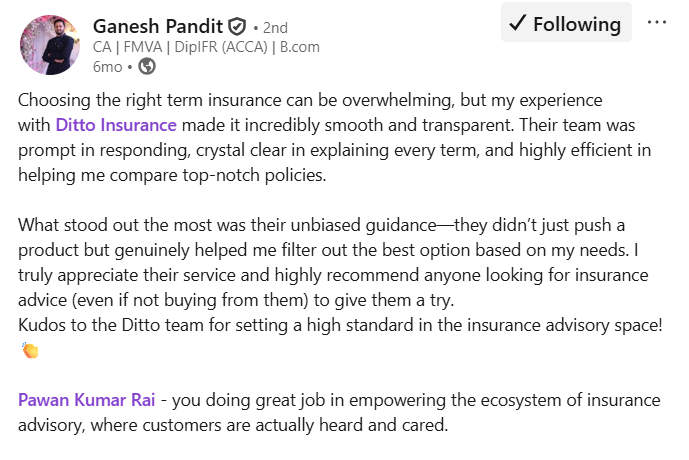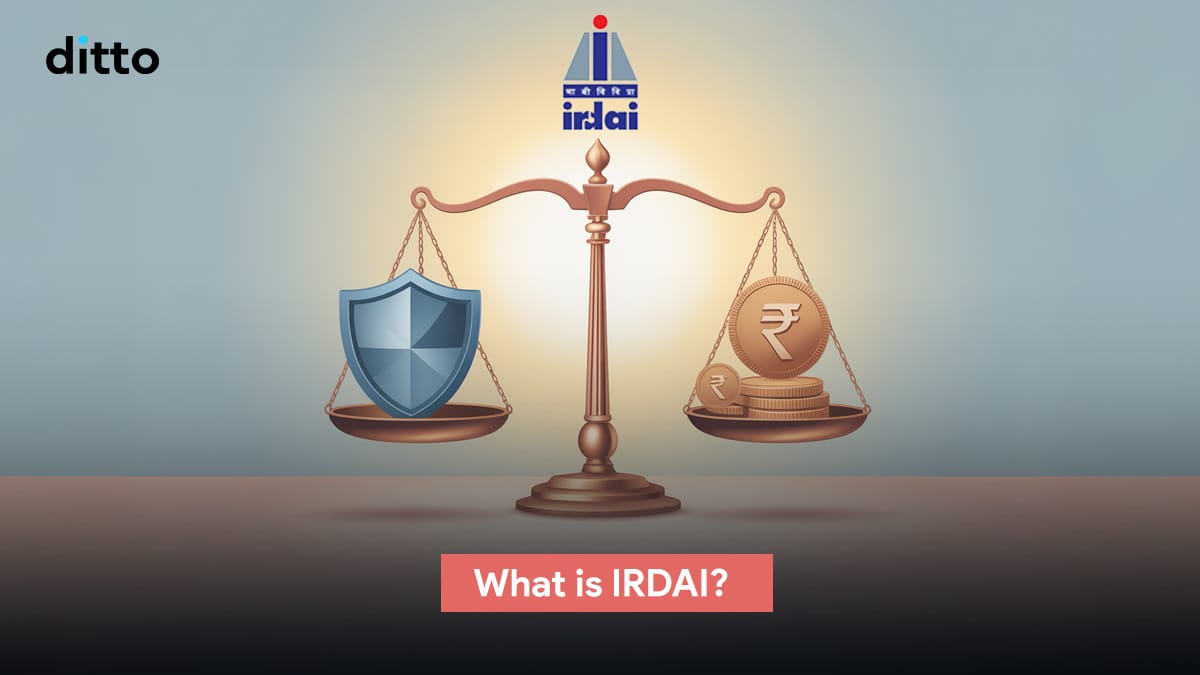| What is IRDAI? The Insurance Regulatory and Development Authority of India (IRDAI) is the apex statutory body regulating and overseeing the insurance and reinsurance sectors in India. It is empowered by Parliament to licence, regulate, supervise, promote, and protect the interests of policyholders in the Indian insurance market. It ensures that insurers remain financially sound, act reasonably, adopt transparent practices, and that the insurance sector contributes to broader economic goals (e.g., financial inclusion, risk coverage). |
Understanding IRDAI, the Insurance Regulatory and Development Authority of India, is key to understanding how India’s insurance system works. In this blog, we’ll break down everything you need to know: what IRDAI is, why it was created, how it regulates insurers, and the latest reforms shaping your policies in 2025. You’ll also learn about its history, structure, functions, and how it protects policyholders like you.
Stay IRDAI-compliant with Ditto — compare only approved policies, track insurer performance, and make transparent, regulation-ready insurance choices in minutes. Book a call today!
An Overview of IRDAI
Before IRDAI came into existence, India’s insurance market was largely state-controlled — LIC for life insurance (since 1956) and public sector firms for general insurance. The push for liberalization in the 1990s led to the Malhotra Committee Report (1994–95), which recommended an independent regulator.
This resulted in the Insurance Regulatory and Development Authority Act, 1999, formally establishing IRDAI in 2000. Its mission: to protect policyholders, regulate and promote fair growth, and maintain financial stability in the insurance sector. Over time, IRDAI has evolved into a modern regulator, balancing innovation with consumer protection, ensuring solvency, and driving inclusion through digital and rural outreach initiatives.
Types of Insurance Policies Regulated by IRDAI
Life Insurance Products
- Term insurance (pure risk cover)
- Endowment policies
- Whole life / limited pay / single premium
- Unit Linked Insurance Plans (ULIPs) — where policyholders bear investment risk
- Annuities/pension plans / deferred annuity
- Group life schemes/group gratuity/group superannuation
- Riders and optional add-ons (accidental death, critical illness, waiver of premium)
For all life products, IRDAI mandates the filing of product documents, limits on rebates, prohibits anti‐competitive practices, requires benefit illustrations, and enforces surrender / paid-up rules.
Health / Medical / Mediclaim
- Individual health / family floater
- Senior citizen health plans
- Group health / employee health schemes
- Critical illness / disease-specific covers
- Hospital cash / fixed benefit riders
- Top-up / super top-up plans
Key IRDAI rules (Health Insurance Regulations 2016, and Master Circulars) specify renewability (on a lifelong basis), waiting periods for pre-existing conditions, standard exclusions, portability, sum insured slabs, moratoriums, co-payments, and no upper age limit requirement.
General / Non-Life Insurance
- Motor Insurance
- Property/fire/home insurance
- Marine/freight / hull insurance
- Liability insurance (public liability, product liability)
- Agricultural / crop insurance
- Aviation, credit, bond, surety, miscellaneous classes
In non-life insurance, IRDAI oversees premium rate-setting for specific products like crop insurance and fire risks, enforces rules for policy filing and usage, sets underwriting and claim settlement standards, and prohibits unfair discrimination among policyholders.
| Did You Know? IRDAI mandates long-term third-party liability cover, 3 years for cars and 5 years for two-wheelers, as per the Supreme Court directive and Ministry of Road Transport & Highways guidelines. However, bundled long-term “package” policies (TP + OD) were discontinued from August 1, 2020, and own-damage cover is now renewed annually. |
Reinsurance & Special Entities
- Reinsurance arrangements (domestic/international)
- GIC Re (General Insurance Corporation of India) operates as the national reinsurer under IRDAI oversight
- Special Purpose Vehicles (SPVs – separate entities created to isolate and manage specific insurance risks), risk pooling mechanisms, and insurance-linked securities (ILS) are tools insurers use to transfer and manage risk efficiently.
- Captive insurers (insurance companies established by a parent firm to cover its own risks), where permitted, are subject to stricter standards.
Distribution & Intermediaries
- Agents / Corporate agents
- Brokers / Reinsurance brokers
- Web Aggregators / Insurance Comparators
- Insurance Repositories (for electronic policy storage)
- TPAs (Third Party Administrators) for health claims
- Surveyors / Loss Assessors
Each of these must be registered, maintain qualifications such as passing IRDAI certification exams and meeting educational criteria, and adhere to the code of conduct, training, and reporting norms.
Above all, IRDAI’s jurisdiction broadly covers the end-to-end insurance value chain: product, underwriting, investment, distribution, claims, grievance redressal, supervision, and exit.
Importance of IRDA (Insurance Regulatory and Development Authority Act) in the Insurance Sector
1) Guarding systemic stability
Insurance companies accept long-term liabilities. If many insurers are undercapitalized or mismanage risk, it can trigger cascading failures. IRDAI’s solvency norms, capital adequacy rules, reinsurance oversight, etc., ensure systemic safety. It also monitors asset-liability matching, investment risk, and credit risk, ensuring insurers do not overexpose themselves to volatile assets.
2) Product standardisation and transparency
IRDAI mandates product filing, standard formats, and common definitions (e.g., “pre-existing disease,” “waiting period”) so consumers can compare policies. It also issues Master Circulars for health, life, and other insurance offerings, to reduce asymmetry. These standardisations also reduce litigation and disputes arising from ambiguous terms.
3) Consumer empowerment & grievance mechanisms
Through Bima Bharosa and the IRDAI Grievance Call Centre (IGCC) helpline, IRDAI provides a first layer of redress. It conducts hearings, orders refunds, directs claim payments, and requests that insurers revise unfair practices. Due to its regulatory authority, its orders carry weight that individual consumer forums often lack. This builds trust for the policyholder, ensuring their policy is in safe hands and that their grievances will be assessed and addressed fairly.
4) Industry development & inclusion agenda
IRDAI often issues guidelines encouraging micro-insurance, rural insurance, weather-indexed crop insurance, insurance literacy programs, and mobile/bancassurance distribution to deepen penetration. In addition, it allows product innovation in controlled “sandbox” environments, pilot schemes, modular riders, and digital distribution models.
5) Regulatory coordination & adapting to new risks
Insurance increasingly overlaps with health, data/privacy, fintech, and climate risk. This is why IRDAI periodically works with other regulators (RBI, IRDA, SEBI, and data regulators) to handle overlapping issues. For instance, IRDAI must account for cyber risk, climate risk, pandemic risk, and parametric insurance, among others, and evolve its frameworks accordingly.
6) Enforcing market discipline
IRDAI can penalize mis-selling, delay in premium remittance (especially by aggregators), unfair marketing, and misleading advertisements. Put simply, it acts as a deterrent and enforcer for ethical conduct. For example, recently, IRDAI fined Policybazaar ₹5 crore for biased product promotion and delays in remitting collected premiums to insurers. In July 2025, IRDAI also fined Star Health and Allied Insurance ₹3.39 crore for violations of the Information & Cyber Security Guidelines, 2023, citing lapses in data protection and cybersecurity compliance.
Together, these roles make IRDAI more than a licensing body; it is the backbone of a stable, trustworthy insurance ecosystem.
How Does IRDAI Work?
To appreciate the mechanics, here’s a deeper look at IRDAI’s operational workflows, checks, and recent innovations:
Rulemaking and stakeholder consultation
- When the IRDAI proposes a new regulation or change (such as for health insurance terms), it issues a draft and invites comments from insurers, consumer groups, experts, state governments, and others. This review board may also constitute expert committees / working groups to study technical issues (actuarial, risk modeling, data analytics).
- After considering feedback, IRDAI issues a final regulation / circular / master circular.
Filing & product vetting
- Insurers submit product filings (wordings, actuarial tables, risk assumptions, rate schedules) to IRDAI.
- IRDAI’s actuarial/technical/legal teams review them for consistency with rules (e.g., mortality tables, reserves, prohibitions, disclosures).
- Some products (high-stakes insurance policies) require revisions or rejection, or may be subject to conditional approval.
Supervision & monitoring
- IRDAI monitors periodic returns (financial statements, solvency returns, investment portfolios) submitted by insurers.
- It may schedule inspections or audit visits, especially for large or risky firms.
- If deviations or red flags are identified, the IRDAI may initiate inquiries, issue show-cause notices, or demand remedial actions.
Enforcement & corrective action
- Upon non-compliance, the IRDAI can levy monetary penalties, issue directions (e.g., stopping new business, rectifying accounts), or suspend/cancel licenses.
- It may issue public notices or warnings.
- IRDAI has quasi-judicial powers for certain disputes, including claim settlement practices and product regulations.
Consumer grievance handling
- Complainants first approach insurers; if unresolved, they can escalate to Bima Bharosa / IRDAI.
- IRDAI undertakes preliminary adjudication and may direct the insurer to act or compensate.
- Beyond that, policyholders may seek recourse to the Insurance Ombudsman or consumer courts if a further dispute arises.
Data, analytics & reporting
- IRDAI is increasingly utilizing technology, including data analytics, dashboards, trend monitoring, early warning signals, and stress tests.
- It publishes aggregate industry data (premium growth, claims ratios, solvency, market share) in its annual reports.
- It may also require insurers to maintain digital records, API interfaces, consumer portals, etc.
| Did You Know? If an insurer in India faces bankruptcy or solvency issues, IRDAI protects policyholders first, not shareholders. In 2017, it took over Sahara India Life and transferred over 2 lakh policies to SBI Life. In 2019, it intervened when Reliance Health Insurance fell below solvency margins, ensuring claims were paid via Reliance General Insurance. Under Sections 52A and 52B of the Insurance Act, 1938, IRDAI can take control, transfer business, or wind up an insurer to safeguard your policy. |
Innovations & digital initiatives
- IRDAI is pushing for digital transformation — e-insurance policies, digital signatures, mobile apps, and cloud infrastructure.
- It is developing or supervising insurance marketplaces — e.g., Bima Sugam, a one-stop platform proposed to make insurance buying, comparison, and servicing seamless.
- It also monitors online aggregators, ensures fair practices, and limits mischief in digital sales.
Functions of IRDAI in the Insurance Industry
Licensing/registration/authorisation
- Any insurer (life, non-life, or reinsurance) must apply for a certificate of registration from IRDAI. IRDAI grants, renews, modifies, suspends, and cancels registrations under stipulated conditions (Section 14 powers).
- Similarly, intermediaries (agents, brokers, corporate agents, web aggregators) must obtain IRDAI certification under respective regulations (e.g., Brokerage Regulations, Web Aggregator Regulations). The Insurance Brokers Regulations, 2018 (and amendments) spell out eligibility, capital norms, and conduct rules for brokers.
- IRDAI also regulates Third Party Administrators (TPAs) for health insurance via TPA (Health Services) Regulations, 2016.
Product regulation & review
- Insurers must file product proposals (wordings, schedules, tables) for IRDAI’s approval or review. This is especially true for life insurance, health insurance, and riders.
- IRDAI enforces product regulations (for life, health, general) specifying minimum requirements, exclusions, rebating norms, etc.
- For health, the Health Insurance Regulations, 2016, provide rules regarding renewal, waiting periods, premium loading, and other related matters. For life insurance, the IRDAI provides rules regarding policy terms, surrender and paid-up options, premium payment structures, product disclosures, and benefit illustrations to ensure transparency and consumer protection.
Supervision, inspection & enforcement
- IRDAI has the authority to request information, conduct audits, inspect records, and initiate inquiries/investigations into insurers, intermediaries, agencies, and health providers in collaboration.
- If violations are found, IRDAI can impose monetary penalties, issue directions, or even suspend/cancel licences.
Regulating solvency, investments & financial soundness
- IRDAI stipulates solvency margins/capital adequacy norms that insurance firms must maintain.
- It prescribes investment norms (limits, asset classes, concentration risk, exposure to equities, real estate, etc.). The IRDAI also monitors asset quality, liabilities matching, reserves, reinsurance cessions, and risk management frameworks.
- The Corporate Governance Guidelines for insurers (2016) issued by IRDAI further mandate board structures, key management persons, risk committees, disclosures, and lock-in periods for promoters.
Consumer protection, disclosure, grievance redressal
- IRDAI mandates disclosure norms (prospectus, product brochures, benefit illustrations, disclaimers).
- It ensures policy wordings are understandable, transparent, and not misleading. The IRDAI also enforces codes of conduct for agents, brokers, claims surveyors, and loss assessors.
- It also works closely with the Insurance Ombudsman scheme, with IRDAI’s decisions often setting precedents for ombudsman awards.
Promoting growth, innovation & inclusion
- As discussed above, the IRDAI encourages micro-insurance, weather-based crop insurance, digital distribution, and usage-based insurance models.
- It also issues guidelines on bancassurance tie-ups, agency networks in rural areas, and insurer partnerships with fintechs. This is done via insurance literacy drives, consumer awareness programs, and collaborations with state/central government schemes.
Coordination, research & international collaboration
- IRDAI participates in international forums (e.g., IAIS, global regulators) to align with global standards.
- It also undertakes research, actuarial studies, publishes reports, and engages with academia and industry.
What are the New Rules Introduced by the IRDAI?
IRDAI frequently updates and fine-tunes its regulations. The most recent reforms, consolidated under the Master Circular on Health Insurance Products (May 29, 2024) and the IRDAI (Insurance Products) Regulations, 2024 (March 20, 2024), mark key updates for 2024–2025.
Removal of the upper age limit in health insurance
- Effective 1 April 2024, the IRDAI mandated that insurers must offer at least one health insurance product with no upper age limit (i.e., with no cap on entry age).
- This is a significant shift from the earlier norm, where many insurers capped entry at 65 years.
- The goal is to enhance access for older persons and expand coverage.
Reduction in waiting period for pre-existing diseases
- In the revised norms, the waiting period for covering pre-existing conditions has been reduced from 4 years to a maximum of 3 years.
- This makes it easier for individuals with pre-existing conditions to obtain meaningful coverage.
Moratorium/lock-in on contesting policy
- Under the updated Insurance Products Regulations / Master Circular 2024, after a moratorium period of 60 months (5 years) of continuous coverage, insurers cannot challenge claims on grounds of misstatement of facts or non-disclosure (except fraud).
- This provides long-term policyholders with greater security following the moratorium.
Capping premium increases for senior citizens
- IRDAI has mandated that renewal premiums for senior citizens cannot increase by more than 10% per year, unless the insurer obtains prior approval from the regulator.
Enhancing oversight of health claims exchange
- The National Health Claims Exchange (NHCX), a portal for health insurance claims interoperability, is being considered for stricter oversight by IRDAI (moving under regulation).
- This is aimed at curbing rising hospital overcharging and improving transparency in the claims process.
Regulatory action against digital/aggregator malpractices
- IRDAI has shown resolve in regulating web aggregators and insurers’ online marketing. In recent years, SBI Life Insurance Co. Ltd., Acko Insurance, and HDFC Life Insurance Co. Ltd. were fined for regulatory violations.
- IRDAI continues to monitor aggregator practices (e.g., biased ranking, hidden commissions, delay in remittance) and enforce compliance.
These reforms demonstrate IRDAI’s evolving role — striking a balance between innovation and consumer rights while ensuring prudential safeguards.
| Did You Know? IRDAI’s vision of “Insurance for All by 2047” aims to ensure every Indian and enterprise has meaningful insurance protection. Key initiatives include Bima Sugam (a unified digital marketplace), Bima Vistaar (an affordable combo cover), and Bima Vaahak (a women-led rural distribution network) — all designed to make insurance accessible, affordable, and trusted nationwide. |
Why Talk to Ditto for Your Insurance?
At Ditto, we’ve assisted over 7,00,000 customers with choosing the right insurance policy. Why customers like Ganesh below love us:

✅No-Spam & No Salesmen
✅Rated 4.9/5 on Google Reviews by 15,000+ happy customers
✅Backed by Zerodha
✅100% Free Consultation
You can book a FREE consultation. Slots are running out, so make sure you book a call now!
Final Thoughts
IRDAI is not a passive regulator; it’s an evolving authority adapting to new insurance challenges (aging, health risk, digital sales, climate, fintech). For policy buyers, it’s essential to refer to the latest IRDAI master circulars and notices before opting for a policy and stay updated on the rules that can impact your coverage, claim processing, and grievance redressal processes.
Overall, IRDAI serves as both a rulemaker and enforcer that is shaping the growth of insurance in India.
FAQs
What is the primary role of IRDAI?
IRDAI regulates and supervises India’s insurance sector, ensuring insurers remain financially sound, follow transparent practices, and protect policyholders’ interests.
Which types of insurance products does IRDAI regulate?
IRDAI oversees life insurance, health/medical insurance, and general/non-life insurance, including term plans, ULIPs, health policies, motor, property, liability, and crop insurance.
How does IRDAI protect policyholders?
It enforces product transparency, grievance redressal mechanisms, solvency norms, claim settlement standards, and can intervene in insurer failures to safeguard policyholders.
What powers does IRDAI have over insurers and intermediaries?
IRDAI can grant, renew, modify, suspend, or cancel licenses, inspect operations, impose penalties, and issue directives for compliance with regulatory norms.
How has IRDAI updated health insurance rules recently?
Recent reforms include removing upper age limits for health policies, reducing waiting periods for pre-existing diseases, capping renewal premium hikes for seniors, and strengthening oversight of digital aggregators.
Last updated on:







